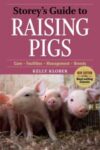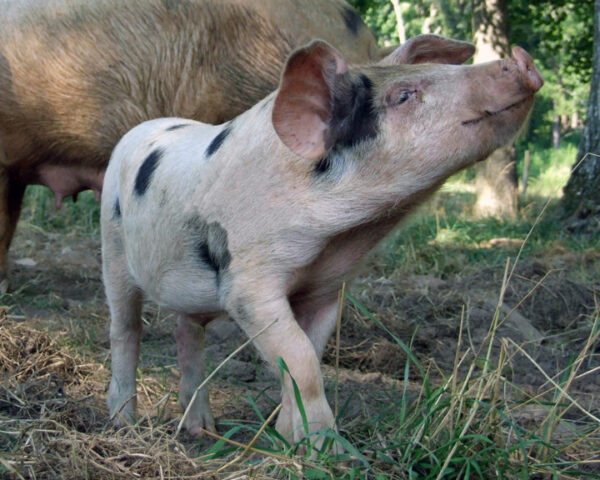
Breed Facts
Status:
Threatened
Use:
Meat, Lard/Back Fat
Adult Weight:
Male – 600 lbs.
Female – 500 lbs.
Temperament:
Docile
Experience Level:
Beginner – Intermediate
Notes:
Good mothers; May be used for Loin, Roasts, Ham, Bacon, Sausage/Ground, and other retail cuts
GLOUCESTERSHIRE OLD SPOTS
Gloucestershire (pronounced gloster-sheer) Old Spots (GOS), known for their distinctive white coat with black spots, were developed in the Vale of Berkeley in Gloucestershire, England. Recognized as the oldest pedigree spotted pig in the world, the GOS was once popular for small family farms, where they were raised on dairy by-products (such as whey) and orchard “drop fruit,” giving these pigs the nicknames “cottage pig” and “orchard pig.” British folklore claimed the large black spots were bruises caused by apples falling onto them as they foraged the orchard floors for food.
Like many breeds originating before the 20th century, the exact history and ancestry of the Old Spots pig is unknown. GOS pigs were first mentioned in English literature around 1790. The most likely origin is a pairing of the original Gloucestershire pig (a large off-white pig with floppy ears and wattles) and the unimproved Berkshire (a sandy colored pig with prick ears and black spots). Both breeds are now extinct. One other possible contributor is the Lincolnshire Curley Coat, which has also gone extinct. These breeds were considered thrifty and excellent foragers that supplemented their feed with roots and vegetation, had excellent maternal instincts, and an even temperament.
In 1913, the British Board of Agriculture announced a livestock development scheme that included the licensing of breeding boars. Farmers of the Berkley Vale realized this plan threatened the very existence of their beloved local pig breed, so in November 1913 they formed the Gloucestershire Old Spots Breed Society and formed an official herd book, placing the breed among the oldest spotted pedigreed pig breeds known.
The breed reached a high point in popularity in Great Britain just after World War I when the naturally large proportions of lean meat from Old Spots was perfectly suited to the production of lean, streaky bacon popular in Great Britain at the time. Old Spots reigned supreme as the pork of choice for discerning palates and in livestock shows through the 1920s and early 1930s. The breed became rare after World War II when the shift to intensive pig production reduced interest in pigs that were bred to be raised in pastures on orchard windfall, leftovers from cheesemaking, and crop remains, and were raised indoors.
Unfortunately, in the pursuit of creating efficient, industrial hybrids, many commercial sows lost their maternal instincts. GOS were occasionally introduced by industrial breeders to try to recreate this important quality, but this niche was not successful in keeping the GOS from almost going extinct.
Old Spots genetics were used in America in the 20th century to create breeds like the Spotted Poland China, the Chester White, and the American Spot, but GOS pigs never really became popular in the US and neared extinction in the UK by 1977. In 1995, Importation of 20 GOS piglets by the Kelmscott Farm Foundation of Lincolnville, Maine, helped establish a purebred population; a breed society, Gloucester Old Spots of America, Inc., was founded in 1996 to maintain the breed and institutional records. Preservation efforts in Britain and American have been promising, though the breed is still endangered in both countries. The breed also benefits from the continued support of the British Royal Family, which favors pork from these pigs for their table.
The Gloucestershire Old Spots pig is known for its docility, intelligence, and prolificacy. They are hardy and can withstand harsh weather. Boars reach a mature weight of 600 lbs. and sows 500 lbs. The pigs are white with clearly defined black (not blue) spots. There must be at least one spot on the body to be accepted in the registry. The breed’s maternal skills make it able to raise large litters of piglets on pasture. Their disposition and self-sufficiency should make them attractive for farmers raising pasture pigs and those who want to add pigs to diversified operations.
Did you know:
When farms and farmers face a crisis, rare livestock breeds are more likely to be lost. That’s why The Livestock Conservancy offers Emergency Microgrants year-round. As the economy tightens, off-farm jobs are lost, herds are downsized, veterinary emergencies happen, and calamities such as floods, fires, and tornadoes continue. Help us help them. Click here to support the Emergency Response Fund with your gift today.
You may be interested in…

Storey’s Guide to Raising Pigs
– Kelly Klober
$19.95
An Introduction to Heritage Breeds
– D. Phillip Sponenberg, Jeannette Beranger. Alison Martin
$19.95


